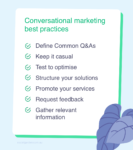BLOG
Conversational Marketing Best Practices
Do you find yourself wondering how you can personalise your relationship with your audience? Whether it’s live chats, chatbots or messaging apps, conversational marketing might be the next step for you. Read on for our top 7 tips for implementing a successful conversational marketing strategy and creating tailored experiences for your potential customers.
What is conversational marketing?
Conversational marketing refers to any one-on-one interactions with customers in real-time. One-to-one marketing offers opportunities to build a more personal relationship with the customer, and provide more value to their experience with your organisation.
These conversational marketing interactions are customisable, meaning we can tailor each touchpoint to the individual customer’s needs. In general, these forms of communication are conversational and quite informal.
There are several ways to undertake and implement conversational marketing. Most often, it looks like live chats and chatbots embedded on a web page, or messaging apps connected to your service.
What are the benefits of conversational marketing?
Other than creating a more approachable brand personality that values personal relationships with each customer, there are several benefits of conversational marketing.
Conversational marketing:
- Helps gather more data and information from your customers
- Moves customers further along the funnel (from Marketing Qualified Leads to Sales Qualified Leads)
- Enriches the customer experience by feeling more connected to the organisation.
Conversational marketing best practices
To make your one-to-one marketing stand out from the crowd, here are our top 7 steps to conversational marketing best practices.
1. Define common Q&As
When setting up your chatbot, a good place to start is by putting yourself in your customer’s shoes. By identifying the most relevant and important questions they might have, you demonstrate that you really understand their needs.
These questions might be led by your knowledge of their concerns or pain points in the market, or maybe by the aspects of your product or service they are likely to be most interested in or curious about. Once you have identified these questions, it’s important to provide relevant answers for the chatbot that are clear, succinct and easily understood.
Remember, each question should be directly relevant to the stage of the customer’s journey, whether they’re top of the funnel or closer to converting on your offering.
2. Keep it casual
The beauty of conversational marketing is its informal style and practice.
Live chats offer the opportunity to be a more personalised touchpoint for the customer than other forms of communication (like email) that are available to us as marketers. That’s why it can be beneficial to use a pop-up greeting to welcome visitors to your page, because it builds trust and adds a human element of friendliness from the outset.
Another way to enhance one-to-one marketing with your customers is to add a face to the name of the person behind the live chat. This makes it easier for the customer to understand who they’re interacting with, and maintains a human connection that isn’t available with other marketing communication methods.
3. Test to optimise
Customer trends change all the time, and your company and its offerings also evolve over time. That’s why it’s so important to ensure that common queries and responses on chatbots or messaging services are updated as frequently as possible.
You can ensure the optimisation of the level of personalisation on your chatbot through constant and regular testing of your set questions and answers.
4. Structure your solutions
When a customer engages with a chatbot, they’re often seeking a solution to an issue they’ve encountered — and they want it within minutes (or even sooner!).
To make sure your conversational marketing tools aren’t creating disgruntled customers via slow responses, ensure all your responses are designed to reply to queries within a few exchanged messages to reduce hassle. And if your live chat or chatbot marketing tools are part of a broader omnichannel marketing strategy, you can ensure that every touchpoint gives the customer an opportunity to address questions relevant to each stage of the customer journey.
5. Promote your services
If each of the previous steps are completed to the right standard, you can use targeted information to strategically bring your leads further down the funnel — and closer to a purchase decision. By offering extra product information, or suggesting similar products which the customer might be interested in, you can increase the likelihood of the lead converting.
It’s also possible to optimise chatbots and integrate appointment bookings, which reduces the necessary touchpoints for conversion.
6. Request feedback
After you’ve invested so much effort into optimising your conversational marketing tools, it’s vital that you ask customers for feedback on their experience.
Ensure this step is optional so customers don’t feel forced into providing feedback, and the feedback you do receive is authentic and willing. It’s a crucial step for implementing improvements to your chatbot or livechat service!
7. Gather relevant information
Gathering relevant data through conversational marketing can add to the future experience of each customer by helping to create personalisation strategies with new information populated into your database.
With personalisation comes trust; conversational marketing is a great way to achieve a trusting, customised relationship each member of your audience!












